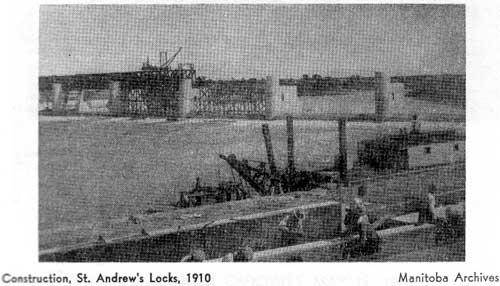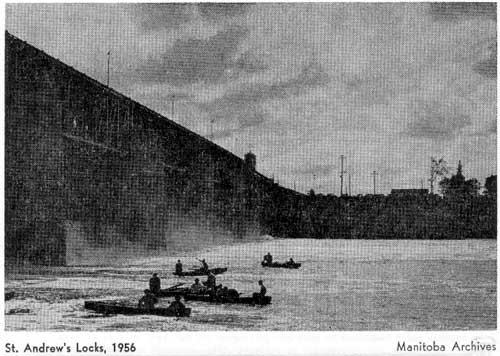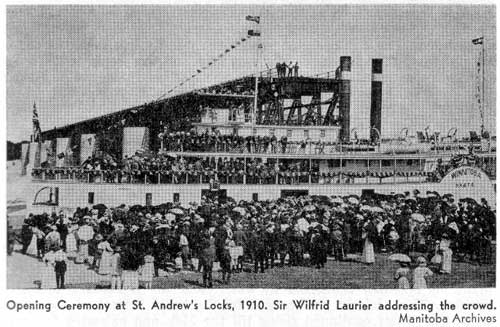Manitoba Pageant, Spring 1966, Volume 11, Number 3
|
The early years of this century were filled with big ideas about the West. A spirit of boom and expansion was in the air as the western prairies filled in with settlers and the railways stretched out to open up new areas. Winnipeg was to become one of the great cities of the continent a world wheat centre - another Chicago.
One of the major engineering developments of this period was the building of the St. Andrew’s Locks at what we now call Lockport. Because of rail and truck transport today we hardly realize how important the building of these locks was and what great developments were expected. But in 1910 it meant that the Red River could be navigated by steamers down to Lake Winnipeg.
In March 1910, the Dominion engineer in Winnipeg announced that the locks would be ready when the ice broke and he asked city officials to see that the swinging spans of the Redwood and Louis bridges were in good working order.
A shipbuilding boom had developed in Winnipeg in preparation for the volume of water transport business expected. Ship building yards sprang up along the river front - gangs of carpenters, painters, and mechanics overhauled ships and engines, built barges and tugs and prepared the steamers for the summer haul of passengers and freight. This Winnipeg fleet included the Winnitoba which could carry 2,000 passengers and thirty-five carloads of freight - the Bonitoba, under construction, was to carry 725 passengers and 300 tons of freight - the Alberta could carry 725 passengers but had no room for freight.

Construction, St. Andrew’s Locks, 1910
Source: Archives of Manitoba
At Selkirk a fleet of twenty-seven ships waited eagerly for the locks to open. They had been unable to pass St. Andrew’s and carry their cargoes from Lake Winnipeg to the city because of the rapids in the Red River. Now the Winnipeg market would be open to them. This was but one development. There were visions and plans for bigger things. Thousands of acres of productive land around Lake Winnipeg which could not expect railway service for years to come would be served by the river boats. Mineral resources, only partly prospected, would be developed. The famous Manitoba Whitefish, known and prized on first class menus as far east as Boston and New York, were in great demand. The boats would help to catch up with a demand of over one hundred carloads a year. Forests along both sides of the lake would provide poplar, pine, spruce, and tamarac which would be shipped easily on barges to help satisfy the building boom in Winnipeg. Saw mills would spring up. Sand and gravel for building purposes could be brought out. Lands unsurveyed and unsettled because settlers had no way of marketing their produce would soon be developed by eager farmers.

St. Andrew’s Locks, 1956
Source: Archives of Manitoba
This is what the locks meant to shipowners, farmers, builders, and manufacturers. The Red River would be navigated down to Lake Winnipeg and a great industrial development would take place all along the river from St. Norbert to the Lake. The river would provide boating and cruising pleasures seldom enjoyed by a city so far inland. The first test of the locks was made on 2 May 1910 when the government steamer Victoria passed through. The locks worked and were declared ready for traffic. The next day the Alberta from Winnipeg cleared the locks and went to Selkirk and the Brokenhead River - the first official trip over the new water highway. This first trip was a slow one because the Alberta had been held up for two and a half hours at Redwood Bridge. The swinging span of the bridge had been tested just a few days before but in closing the span it had become jammed and the fifty horse-power gasoline motor in the operating cabin was not powerful enough to budge it. Not until a set of jacks was sent for and the span opened could the Alberta continue.
14 July 1910 was the big day when the official ceremony of opening the locks took place. Prime Minister Wilfrid Laurier was present on this occasion and spoke to several thousand people from Winnipeg, St. Andrew’s and Selkirk who had gathered for the event. It was a day people had waited years for - and there was a sense of pride in the great engineering achievement that connected Winnipeg with the Lake. Laurier reflected this spirit of boom and expansion in the air when he said that the word "impossible" was not to be found in the language of the Canadian West. St. Andrew’s Locks was to be only the beginning. Already there was talk of a waterways system on the Saskatchewan River to link Edmonton and Winnipeg - a steam connection between Winnipeg and Hudson Bay - a port on Hudson Bay would be nearer Liverpool than New York. And a canal system on the Winnipeg River would allow ocean-going ships to come past Port Arthur and Fort William to the prairie city in the middle of a continent. The flood of grain from this young giant of a city would make it a major centre of transportation and shipping. The opening of St. Andrew’s Locks was really but a small event compared to these dreams and visions. Some day the dream may be a reality for we are still but a young giant.

Opening ceremony at St. Andrew’s Locks, 1910. Sir Wilfrid Laurier addressing the crowd.
Source: Archives of Manitoba
Page revised: 2 September 2020